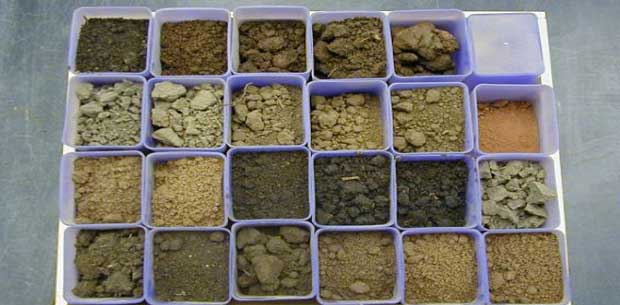
A number of systems of classification have been evolved for categorizing various types of soil. Some of these have been developed specifically in connection with ascertaining the suitability of soil for use in particular soil engineering projects. Some are rather preliminary in character while a few are relatively more exhaustive, although some degree of arbitrariness is necessarily inherent in each of the systems.
The more common classification systems are enlisted below:
- Geological Classification
- Classification by Structure
- Classification based on Grain-size
- Unified Soil Classification System
- Preliminary Classification by soil types
Geological Classification
Soil types may be classified on the basis of their geological origin. The origin of a soil may refer either to its constituents or to the agencies responsible for its present status.
Based on constituents, soil may be classified as:
- Inorganic soil
- Organic soil
Based on the agencies responsible for their present state, soils may be classified under following types:
- Residual Soils
- Transported Soils:
- Alluvial or sedimentary soils
- Aeolian soils
- Glacial soils
- Lacustrine soils
- Marine soils
Over the geological cycle, soils are formed by disintegration and weathering of rocks. These are again formed by compaction and cementation by heat and pressure.
Classification by Structure
Depending upon the average grain-size and the conditions under which soils are formed and deposited in their natural state, they may be categorized into following types on the basis of their structure:
- Soils of single-grained structure
- Soils of honey-comb structure
- Soils of flocculent structure
Classification based on grain-size
In the grain-size classification, soils are designated according to the grain-size or particle-size. Terms such as gravel, sand, silt and clay are used to indicate certain ranges of grain-sizes. Since natural soils are mixtures of all particle-sizes, it is preferable call these fractions as sand size, silt size, etc. A number of gain-size classifications have been evolved, but the commonly used ones are:
- S. Bureau of Soils and Public Roads Administration (PRA) System of U.S.A.
- International Classification, propsed at the International Soil Congress at Washington, D.C., in 1927
- Massachusetts Institute of Technology (MIT) System of Classification of U.S.A.
- Indian Standard Classification (IS: 1498-1970)
Unified soil classification system
This system was originally developed by A. Cassagrande and adopted by the U.S. Corps of Engineers in 1942 as ‘Airfield Classification’. It was later revised for universal use and redesignated as the “Unified Soil Classification” in 1957.
In this system soils are classified into three broad categories:
- Coarse-grained soils with up to 50% passing No. 200 ASTM Sieve
- Fine-grained soils with more than 50% pass No. passing No. 200 ASTM Sieve
- Organic soils
Preliminary Classification by soil types
Familiarity with common soil types is necessary for an understanding of the fundamentals of soil behaviour. In this approach, soils are described by designation such as Boulders, Gravel, Sand, Silt, Clay, Rockflour, Peat, China Clay, Fill, Bentonite, Black Cotton soil, Boulder Clay, Caliche, Hardpan, Laterite, Loam, Loess, Marl, Moorum, Topsoil and Varved Clay.
Terminology of different types of soil
A geotechnical engineer should be well versed with the nomenclature and terminology of different types of soils. The following list gives the names and salient features of different types of soil, arranged in alphabetical order.
-
- Bentonite: It is a type of clay with a very high percentage of clay mineral – montmorillonite. It is a highly plastic clay, resulting from the decomposition of volcanic ash. It is highly water absorbent and has high shrinkage and swelling characteristics.
- Black cotton soil: It is a residual soil containing a high percentage of the clay mineral – montmorillonite. It has very low bearing capacity and high swelling and shrinkage properties.
- Boulders: Boulders are the rock fragments of large size, more than 300mm in size.
- Calcareous soil: This type of soil contains a large quantity of calcium carbonate. Such soils effervesce when tested with weak hydrochloric acid.
- Caliche: It is a type of soil which contains gravel, sand and silt. The particles are cemented by calcium carbonate.
- Clay: It consists of microscopic and sub-microscopic particles derived from the chemical decomposition of rocks. It contains a large quantity of clay mineral. It can be made plastic by adjusting the water content. It exhibits considerable strength when dry. Clay is a fine-grained soil. It is a cohesive soil. The particle size is less than 0.002mm.
Organic clay contains finely divided organic matter and is usually dark grey or black in colour. It has a conspicuous odour. Organic clay is highly compressible and its strength is very high when dry. - Cobbles: Cobbles are large size particles in the range of 80mm to 300mm.
- Diatomaceous earth: Diatoms are minute unicellular marine organisms. Diatomaceous earth is a fine, light grey, soft sedimentary deposit of the silicious remains of skeletons of diatoms.
- Dispersive clays: These are special type of clays which defloculate in still water. Such soils erode if exposed to low-velocity water. Susceptibility to dispersion depends upon the cations in the soil pore water.
- Dune sands: These are wind-transported soils. These are composed of relatively uniform particles of fine to medium sand.
- Expansive clays: These are prone to large volume changes as the water content is changed. These soils contain the mineral montmorillonite.
- Fills: All manmade deposits of soil and waste-materials are called fills. These are the soil embankments raised above the ground surface. Engineering properties of fills depend upon the type of soil, its water content and the degree of compaction.
- Gravel: It is a type of coarse-grained soil. The particle size ranges from 4.75mm to 80mm. It is a cohesion-less material.
- Hardpans: H8ardpans are the types of soil that offer great resistance to the penetration of drilling tools during soil exploration. The soils are designated hardpans regardless of their particle size. These are generally dense, well-graded, cohesive aggregates of mineral particles. Hardpans do not disintegrate when submerged in water.
- Humus: It is a dark brown, organic amorphous earth of the topsoil. It consists of partly decomposed vegetal matter. It is not suitable for engineering works.
- Kankar: It is an impure form of lime stone. It contains calcium carbonate mixed with some silicious material.
- Laterites: Laterites are residual soils formed in tropical regions. Laterites are very soft when freshly cut but become hard after long exposure. Hardness is due to cementing action of iron oxide and aluminium oxide. These soils are also called lateritic soils.
- Loam: It is a mixture of sand, silt and clay. The term is generally used in agronomy. The soil is well suited to tilling operations.
- Loess: It is a windblown deposit of silt. It is generally of uniform gradation, with the particle size between 0.01 and 0.05 mm. It consists of quartz and feldspar particles, cemented with calcium carbonate or iron oxide. When wet, it becomes soft and compressible because cementing action is lost. A loess deposit has a loose structure with numerous root holes which produce vertical cleavage. The permeability in the vertical direction is generally much greater than that in the horizontal direction.
- Marl: It is a stiff, marine calcareous clay of greenish colour.
- Moorum: The word moorum is derived from a Tamil word, meaning powdered rock. It consists of small pieces ofdisintegrated rock or shale, with or without boulders.
- Muck: It denotes a mixture of fine soil particles and highly decomposed organic matter. It is black in colour and of extremely soft consistency. It cannot be used for engineering works. The organic matter is in an advanced stage of decomposition.
- Peat: It is a type of organic soil having fibrous aggregates of macroscopic and microscopic particles. It is formed from vegetal matter under conditions of excess moisture, such as in swamps. It is highly compressible and not suitable for foundations.
- Sand: It is a coarse-grained soil, having particle size between 0.075 mm to 4.75 mm. The particles are visible to naked eye. The soil is cohesionless and pervious.
- Silt: It is a fine-grained soil, having particle size between 0.002 mm and 0.075 mm. The particles are not visible to naked eyes. Inorganic silt consists of bulky, equidimensional grains of quartz. It has little or no plasticity, and is cohesionless. Organic silt contains an admixture of organic matter. It is a plastic soil and is cohesive.
- Till: It is a type of soil formed by an unstratified deposit resulting from melting of a glacier. The deposit consists of particles of different sizes, ranging from boulders to clay. The soil is generally well-graded. It can be easily densified by compaction. Till is known as boulder-clay.
- Top soils: Top soils are the surface soils that support plants. They contain a large quantity of organic matter and are not suitable for foundations.
- Tuff: It is a fine-grained soil composed of very small particles ejected from volcanoes during its explosion and deposited by wind or water.
- Tundra: It is a mat of peat and shrubby vegetation that covers clayey subsoil in arctic regions. The deeper layers are permanently frozen and are called permafrost. The surface deposit is the active layer which alternately freezes and thaws.
- Varved clays: These are sedimentary deposits consisting of alternate thin layers of silt and clay. The thickness of each layer seldom exceeds 1 cm. These clays are the results of deposition in lakes during periods of alternately high and low waters.

